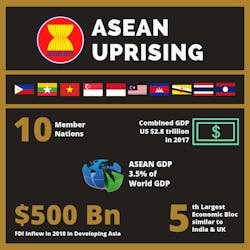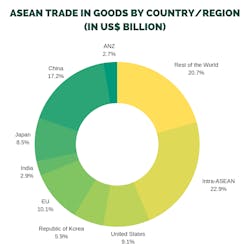With tensions escalating between world’s two largest economies – US and China, many businesses are holding their cards up close due to uncertainties looming large. Several doubts loom large over US and Chinese tech companies and manufacturing units. In light of the recent blacklist by the US government on Huawei, many American companies are now tied down and cannot supply to the Chinese tech giant which would cause a significant reduction in business.
Companies which set shop in China due to it being a great platform for low cost production are ready to hit the panic button. This has paved the way for rise of ASEAN powers in the manufacturing sector, especially within the electronics industry.
Economic Impacts of Trade War
As USA accused China of not adhering to international fair-trade laws and violating intellectual property rights, severe tariffs were imposed on China by the US. When tariffs skyrocketed as a result of this economic conflict, manufacturers, suppliers and Original Equipment Manufacturers (OEMs) were all found wanting with tough business decisions to make. An intensive electronics industry which has thrived in China’s cost-effective base is now facing the repercussions of this global face-off.
A sharp hike in tariffs directly escalates the price of end products which results in consumers having to face the effects of the existing macroeconomic conditions. To continue being competitive, these companies might have to cut down on margins to sustain their business.
Setback in Electronics Supply Chain
The current state of affairs in the manufacturing side of things looks murky due to the complexities observed in various supply chains.
For many EMS companies, this has posed a litmus test since their manufacturing plants are based out of China while their supply chains link back to customers in the United States and other western countries. Also, OEMs which import or export out of China seem to be feeling the pinch.
Most consumer electronic goods are directly being impacted and companies dealing with these products have had to face the consequence of tariff hikes and trade barriers.
As far as the Huawei situation is concerned, many companies who supply components to Huawei would now face a revenue cut as well. Semiconductor firms such as Skyworks, Qorvo, Micron Technologies which supply Huawei with certain front-end modules and flash storage components for smartphones would now have to suspend their partnership and face a substantial revenue-cut.
Impact of US-China Trade War on ASEAN
While companies might be left wondering what went wrong, the ASEAN bloc couldn’t have asked for anything better to boost an already emerging economy.
ASEAN on the Map
The Association of Southeast Asian Nations (ASEAN) comprising of 10 countries in South-Eastern Asia which enable ease-of-trade amongst themselves and with other nations across the world. Formed on the back of a conflict between US & then Soviet Union in the 1970s, it now again finds itself in the midst of another one between the current superpowers – US & China.
This trade war has genuinely pushed countries like Vietnam, Myanmar, Philippines, and Thailand into the main picture.
A country like Vietnam which has a relative advantage over other countries in the electronics sector stands to benefit immensely. In the first 10 months of 2018, Vietnam exported over US $7.94 billion worth electronic components and products.
Overall, these nations would be focused on re-living the model of development exhibited by China whereby manufacturing and foreign-direct investments can help create an environment for a period of extensive growth and progress.
Manufacturing Shift to ASEAN
Companies are rapidly looking to shift base to alternative locations to aid in their pursuit of global expansion, especially in the electronics supply chain. By the time US and China resolve their differences, the electronics supply chain would have witnessed a major paradigm shift in terms of manufacturing as well as distribution.
The massive exchange of goods in this sector has pushed ASEAN to global prominence in trade. This translates well for those operating in the electronics sector as it can help push local goods to overseas markets. As a result of this, several local players are emerging who all have something valuable to offer.
However, there are some challenges associated with relocation as well which can hamper the progress of these firms. Manufacturing and distributing electronic components require technical know-how and skilled human resources. Therefore, companies shifting to ASEAN face an uphill task in ensuring that they can efficiently replicate their cost-effective process flows from China.
Electronic Components Distribution in ASEAN
Distributors situated within the region now have a significant role to play in streamlining these manufacturing efforts to reach the right customers.
Supreme Components International is one such premium, mid-sized distributor based out of Singapore which functions actively in this economic region. Their strategic location has enabled them to steer clear of the crowd and guarantee quality services in ASEAN, Australia-New Zealand & India along with some affiliations in the West.
With a dedicated local presence in most ASEAN countries, SCI has assumed a pivotal role in connecting suppliers to OEMs as the demand for electronic components keeps on surging. Language barriers can be a significant factor impeding progress but with specialized local professionals in its workforce, SCI has negated that threat to transform it into an inherent advantage.
What Next?
For manufacturing companies to stay relevant, they have to cut margins and look at other buyers who may be able to eliminate lead time considerably and provide value-adds. Also, shifting production to other ASEAN countries from China can be a move which pays rich dividends in the future.
While the economic shift is still at a nascent stage, companies can ensure that they get a head start while trade volumes are relatively lesser. The readiness of South-East Asian countries to adopt new technologies in their supply chain makes manufacturing more efficient and can breathe a new lease of life into trade relations between US and Asian markets.











